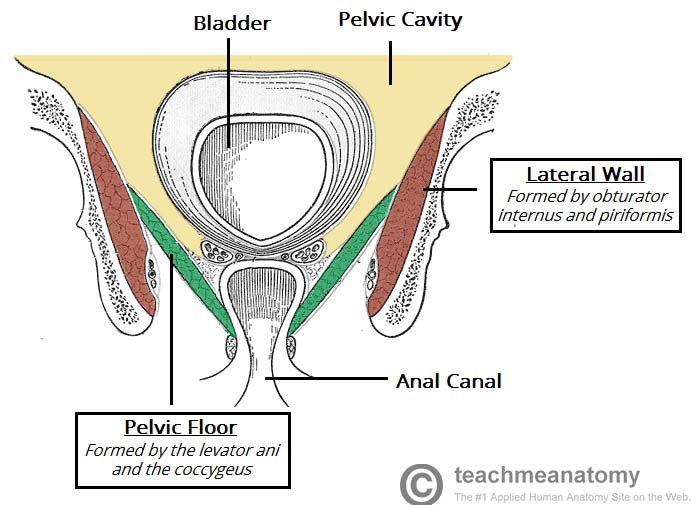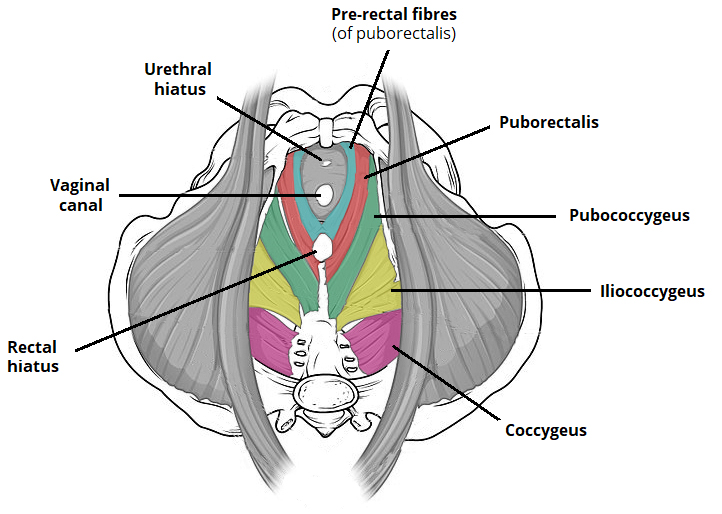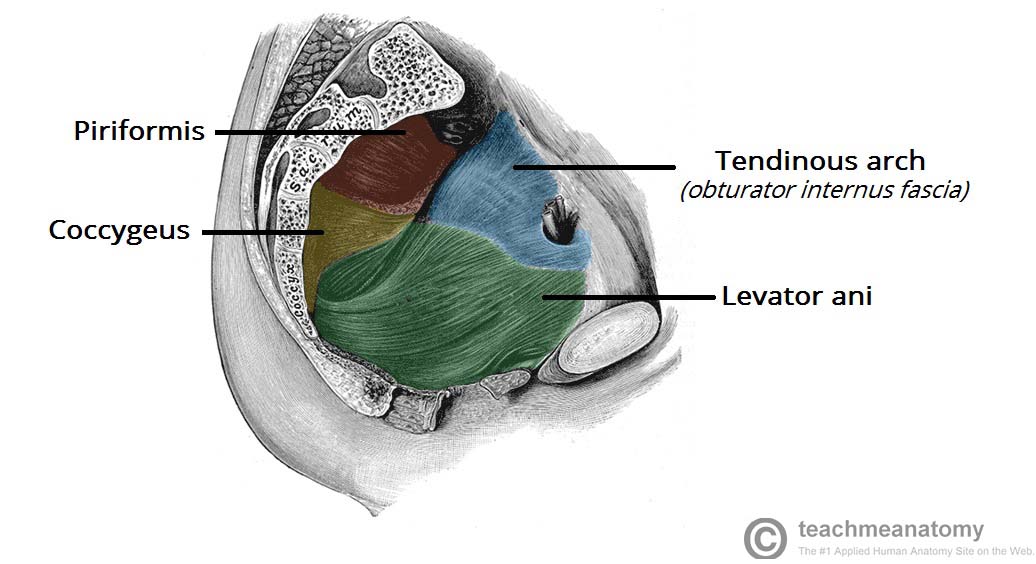Pelvic Muscles
The Pelvic Floor
The pelvic viscera (bladder, rectum, pelvic genital organs and terminal part of the urethra) reside within the pelvic cavity (or the true pelvis). This cavity is located within the lesser part of the pelvis, beneath the pelvic brim.
A number of muscles help make up the walls of the cavity – the lateral walls include the obturator internus and the pirformis muscle, with the latter also forming the posterior wall
In this article, we shall look at the anatomy of the muscles that make up the inferior lining of the cavity; the pelvic floor muscles. The pelvic floor is also known as the pelvic diaphragm.

Note – some texts consider the pelvic floor to include the perineal membrane and deep perineal pouch. We have considered these as a distinct and separate structures.
Pelvic Floor Structure
The pelvic floor is a funnel-shaped structure. It attaches to the walls of the lesser pelvis, separating the pelvic cavity from the perineum inferiorly (region which includes the genitalia and anus).
In order to allow for urination and defecation, there are a few gaps in the pelvic floor. There are two ‘holes’ that have significance:
- Urogenital hiatus – an anteriorly situated gap, which allows passage of the urethra (and the vagina in females).
- Rectal hiatus – a centrally positioned gap, which allows passage of the anal canal.
Between the urogenital hiatus and the anal canal lies a fibrous node known as the perineal body, which joins the pelvic floor to the perineum
Functions
As the floor of the pelvic cavity, these muscles have important roles to play in the correct functioning of the pelvic and abdominal viscera.
The roles of the pelvic floor muscles are:
- Support of abdominopelvic viscera (bladder, intestines, uterus etc.) through their tonic contraction.
- Resistance to increases in intra-pelvic/abdominal pressure during activities such as coughing or lifting heavy objects.
- Urinary and faecal continence.The muscle fibres have a sphincter action on the rectum and urethra. They relax to allow urination and defecation.
Muscles
When learning about the muscles of the pelvic floor, it is important to keep in mind its funnel-shaped structure. There are three main components of the pelvic floor:
- Levator ani muscles (largest component).
- Coccygeus muscle.
- Fascia coverings of the muscles.
Levator Ani Muscles
Innervated by the anterior ramus of S4 and branches of the pudendal nerve (roots S2, S3 and S4).
The levator ani is a broad sheet of muscle. It is composed of three separate paired muscles; pubococcygeus, puborectalis and iliococcygeus.
These muscles have attachments to the pelvis as follows:
- Anterior – pubic bodies of the pelvic bones.
- Laterally – thickened fascia of the obturator internus muscle, known as the tendinous arch.
- Posteriorly – ischial spines of the pevlic bones.
Puborectalis
The puborectalis muscle is a U-shaped sling, extending from the bodies of the pubic bones, past the urogenital hiatus, around the anal canal. Its tonic contraction bends the canal anteriorly, creating the anorectal angle (90 degrees) at the anorectal junction (where the rectum meets the anus).
The main function of this thick muscle is to maintain faecal continence – during defecation this muscle relaxes.
Some fibers of the puborectalis muscle (pre-rectal fibers) form another U-shaped sling that flank the urethra in the male and the urethra and vagina in the female (in some textbooks they appear as pubovaginalis or sphincter urethrae / vaginae). These fibers are very important in preserving urinary continence, especially during abrupt increase of the intra-abdominal pressure i.e. during sneezing.

Pubococcygeus
The muscle fibres of the pubococcygeus are the main constituent of the levator ani. They arise from the body of the pubic bone and the anterior aspect of the tendinous arch. The fibres travel around the margin of the urogenital hiatus and run posteromedially, attaching at the coccyx and anococcygeal ligament.
Iliococcygeus
The iliococcygeus has thin muscle fibres, which start anteriorly at the ischial spines and posterior aspect of the tendinous arch. They attach posteriorly to the coccyx and the anococcygeal ligament.
This part of the levator ani is the actual “levator” of the three: its action elevates the pelvic floor and the anorectal canal.
Coccygeus
Innervated by the anterior rami of S4 and S5.
The coccygeus (or ischiococcygeus) is the smaller, and most posterior pelvic floor component – as the levator ani muscles are situated anteriorly.
It originates from the ischial spines and travels to the lateral aspect of the sacrum and coccyx, along the sacrospinous ligament.
